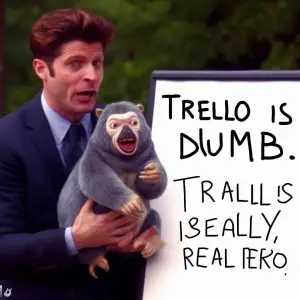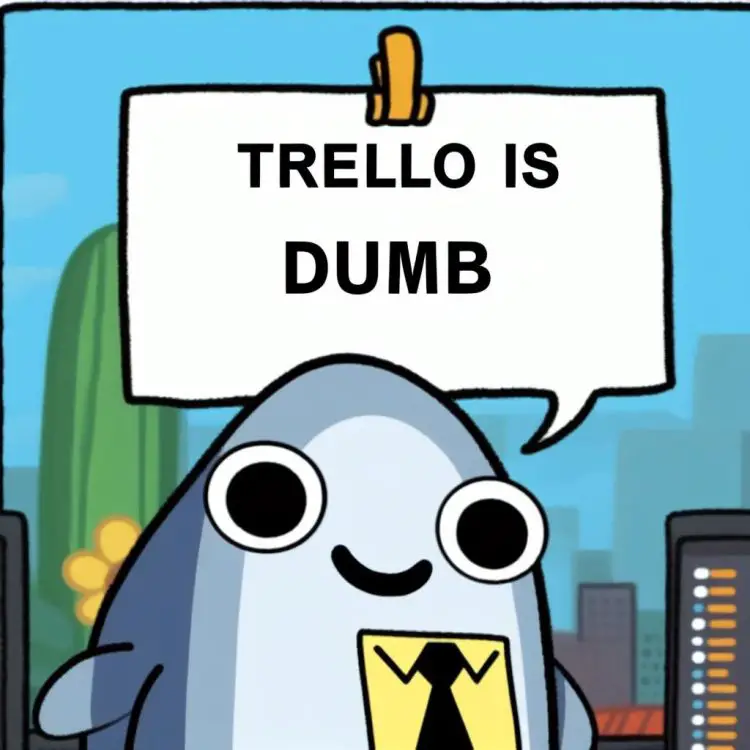This post was most recently updated on July 26th, 2024.
4 min read.This article explains how to easily(?) restore the description (or any other field) of a Trello card. This might come in handy, and the UI for this isn’t exactly obvious (read: it’s nonexistent).
Background
If you’re like me, you’re a heavy (if a bit reluctant) Trello user. Using it all day long, you will before or later run into a situation where you mistakenly (or due to a technical glitch or stupid design) remove the contents of a card and are unable to restore them.
As a side note: Yes, my career really has regressed to the point where I blog about Trello, and not something cool like Blazor, MAUI or at least SharePoint. Instead of hacking together all kinds of fun things, I write haphazard specs and attach quickly drawn mock-ups of architecture diagrams on Trello cards. I’m a living example of the Peter Principle in practice. But I digress.
Anyway, that Trello card that now has no content and you can only blame yourself – let’s get back to that problem.
Okay, maybe you can blame someone else. Sure. Do that if it makes you feel better about yourself and your career.
And maybe it really was someone else removing the contents or changing the title or whatever the issue might be! Maybe it wasn’t. The method to recover the data is the same.
Solution
Before actually solving the problem, let’s address the obvious elephant in the room: If it indeed was YOU removing the contents and you still have the card open in your browser window, hit CTRL+Z.
And if that didn’t work and someone offers you an extension, be wary. Extensions can do all kinds of nasty stuff. And besides, you don’t actually need one.
Say what? Yeah, no, there’s an API you can use. And you can use it in browser.
Time needed: 20 minutes
How to restore previous contents of your card in Trello?
- Get the ID of your card
First, we’ll need the id of your card. You might know this already, but you can grab it from the URL after the part that says /c/. In my sample below, card id is H65WGtkZ.

- Navigate to https://trello.com/1/cards/[id] to see your card
Now you can call the API with the id of the card. You can do this in the browser since you already have an active session – navigate to https://trello.com/1/cards/[id]/actions?filter=updateCard:desc to get your card’s latest changes.
This way, you’ll get the latest changes (type=”updateCard”) to your card in a descending order. Nifty! - Find the part that says “old”
Now we’ll need to get the old values. For me, the latest change was the one that overwrote the actual contents (shown as “asdf” overwriting the good “old” stuff in the sample below), but of course if you need to go further in the history, it might take a bit of browsing for you.
It’s helpful to use some way to prettify the JSON, I’m using a browser extension (right after berating them in principle, yes) but you could just as well copy-paste the contents into Notepad++ (where you can use, of course, a plug-in to format them nicely).
Anyway – under “old” you’ll find the old values for your different fields. In my case, just “desc” changed, and it changed quite dramatically.
- Copy-paste the field to VS Code
Now we’ll want to fix the formatting. You can’t just copy-paste the contents into Trello, because that’d be too simple. You’ll need to replace at least the line breaks.
You can probably do this somewhere online, too, but I chose to use VS Code for this because why wouldn’t I. Copy-paste the contents into a new VS Code file. - Replace newline escape sequences with actual new lines
Now you can hit ctrl+H (or alternatively action button + shift + command-alternator + kverg-tab + H if you’re on Mac) to bring up the search & replace dialog.
Search for “\n” (newline escape sequence), and in the replace-textbox just hit shift+enter. This’ll let you replace all characters for the newlines (\n) with what’s actually interpreted as a new line.
Sounds convoluted but try copy-pasting the content with the escape sequences not replaced or properly interpreted into Trello, and you’ll first get a code-block, and if you choose to paste without formatting, you’ll just get a wall of text without any line-breaks (or any other formatting – even markdown!)
- Copy-paste the replaced text into Trello
Now you’re finally ready to copy-paste the text back into Trello! You’ll still want to do this without formatting by pasting with ctrl+shift+v (or, again, action pad right click + escape combulator + shifteral + v on Mac), and Trello should interpret your content as markdown again.
All done! Easy when you know it, I guess, but unless you’ve had to do it, reverting your changes or restoring an earlier version of a Trello card is not exactly easy 😅
Have you found an easier way to do this? Do you hate Trello with a passion? Do you have other great Clippy/Trello meme mashups to share? Let me know in the comments -section below!
References and footnotes
Note 1: I probably don’t suck at my job
I’m joking about the Peter Principle. Mostly.
Note 2: Clippy facelift
The main picture of this article is Microsoft’s Copilot for Bing’s rendition of Clippy saying “Trello is dumb”. I’m not trying to incite a clan war or anything, trust me, but also this was a hilarious disappointment.
Some of the other generated images were funnier but this one was so off-brand I decided to go with it. I can appreciate the dadaistic, mildly nonsensical approach, though.




